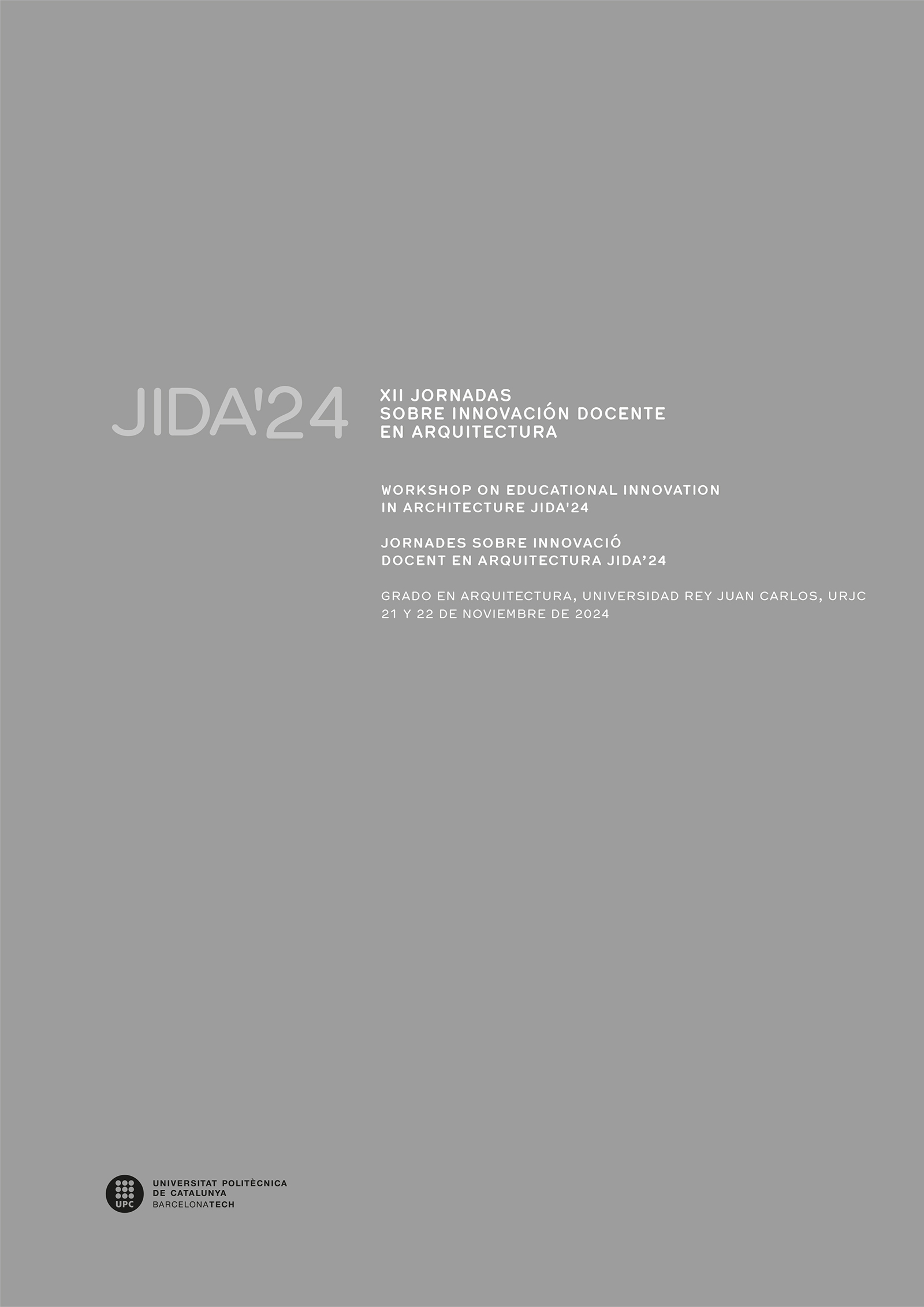BIM Modeling in Residential Design: Parametric strategies of Digital Architecture
DOI:
https://doi.org/10.5821/jida.2024.13318Keywords:
materiality, parametric design, social housing, BIM modelingAbstract
The present study analyzes the pedagogical transition from traditional techniques to digital architecture through the implementation of BIM methodology in social housing programs in Ecuador. Based on digital surveys, the materiality of these housing units is examined using advanced tools in Revit, carried out by undergraduate students from the BIM and BIM II courses in the Interior Design and Architecture grade. This approach enables the simulation of multiple sustainable scenarios, conducting a systematic comparison through the parametric analysis of architectural and construction design. The implemented pedagogical strategies promote collaborative and dynamic learning, integrating advanced simulation technology to enhance design comprehension. This work contributes to the development of proposals that maximize sustainability and adaptability in the lifecycle of residential projects, as part of a Competitive Research Fund Project promoted by the educational institution.
References
Bogler, Miriam. 2020. “The Educational Theories in Project-Based Learning.” https://projectpals.com/the-educational-theories-in-project-based-learning/.
Brown, J., A. Smith, y K. Davis. 2022. BIM and Sustainability in Architectural Design. New York: Routledge.
Caetano, Inês, y A. Leitão. 2018. “Integration of an Algorithmic BIM Approach in a Traditional Architecture Studio.” J. Comput. Des. Eng. 6 (November):327-36. https://doi.org/10.1016/J.JCDE.2018.11.004.
Chen, Rui, Xiaoping Feng, Chengjing Li, y Chen Huapeng. 2021. “Reduction of Carbon Dioxide Emission and Energy Saving Obtained by Improving Building Envelops.” Aerosol and Air Quality Research. https://doi.org/10.4209/aaqr.210084.
Gan, Jielong, Kexin Li, Xiuqi Li, Emil Mok, Patrick Ho, Jenny Law, Joey Lau, Raymond Kwok, y R. Yau. 2023. “Parametric BIM-Based Lifecycle Performance Prediction and Optimisation for Residential Buildings Using Alternative Materials and Designs.” Buildings. https://doi.org/10.3390/buildings13040904.
Gao, Weijun, T. Ariyama, T. Ojima, y A Meier. 2001. “Energy Impacts of Recycling Disassembly in Residential Buildings.” Energy and Buildings 33:553-62. https://doi.org/10.1016/S0378-7788(00)00096-7.
Girardet, Alexis, y Conrad Boton. 2021. “A Parametric BIM Approach to Foster Bridge Project Design and Analysis.” Automation in Construction 126:103679. https://doi.org/10.1016/J.AUTCON.2021.103679.
González, M. 2019. “Circularidad En La Construcción: Un Enfoque Sostenible Para El Siglo XXI.” Revista de Arquitectura Sostenible 15 (3): 123-35.
He, R., Mingkai Li, V Gan, y Jun Ma. 2021. “BIM-Enabled Computerized Design and Digital Fabrication of Industrialized Buildings: A Case Study.” Journal of Cleaner Production 278:123505. https://doi.org/10.1016/j.jclepro.2020.123505.
Hossein Atashbar, y E. Noorzai. 2023. “Optimization of Exterior Wall Cladding Materials for Residential Buildings Using the Non-Dominated Sorting Genetic Algorithm II (NSGAII).” Sustainability. https://doi.org/10.3390/su152115647.
Johnson, K. 2021. “Active Learning Strategies in Higher Education.” Journal of Educational Development 34 (2): 145-59.
Kim, S. 2019. Revisiting Bloom’s Taxonomy in the Digital Age. New York: Academic Publishing.
Manrique, Juan D., M Al-Hussein, A. Bouferguene, y Reza Nasseri. 2015. “Automated Generation of Shop Drawings in Residential Construction.” Automation in Construction 55 (March):15-24. https://doi.org/10.1016/J.AUTCON.2015.03.004.
McInerney, D. M., y V McInerney. 2018. Educational Psychology: Constructing Learning. 5th ed. Sydney: Pearson.
Miller, J. 2021. “Digital Platforms and Collaborative Learning: A New Era in Education.” Educational Technology Journal 58 (3): 78-92.
Nardi, I., T. D. Rubeis, E. Buzzi, S. Sfarra, D. Ambrosini, y D. Paoletti. 2016. “Modeling and Optimization of the Thermal Performance of a Wood-Cement Block.” Energies 9:1-17. https://doi.org/10.3390/EN9090677.
P. Tzortzopoulos Ling Ma, y João Soliman Junior L Koskela. 2019. “Evaluating Social Housing Retrofit Options to Support Clients’ Decision Making-SIMPLER BIM Protocol.” Sustainability. https://doi.org/10.3390/SU11092507.
Quddus Tushar M. Bhuiyan, y Guomin Zhang T Maqsood. 2021. “An Integrated Approach of BIM-Enabled LCA and Energy Simulation.” Journal of Cleaner Production, 125622. https://doi.org/10.1016/j.jclepro.2020.125622.
Rashidi, S., J. A. Esfahani, y N. Karimi. 2018. “A Review on Materials for Building Energy Technologies: Macro to Nano Scales.” Renewable and Sustainable Energy Reviews. https://doi.org/10.1016/J.RSER.2018.03.092.
Rodríguez, A. 2022. Active Learning and Digital Pedagogy in Contemporary Classrooms. Madrid: Universidad Autónoma de Madrid.
Sadeghifam, A. N.; Moharrami, Mahdi; Meynagh; S., Tabatabaee; Amir, Mahdiyar; A., y Memari; S., Ismail. 2019. “Assessment of the Building Components in the Energy Efficient Design of Tropical Residential Buildings.” Energy, 116080. https://doi.org/10.1016/j.energy.2019.116080.
Salazar, P. 2021. “Aprendizaje Colaborativo En Entornos Digitales: Innovación En La Enseñanza Del Diseño Arquitectónico.” Educación y Arquitectura 7 (2): 45-60.
Xin Gong P. Michel, y R. Cantin. 2019. “Multiple-Criteria Decision Analysis of BIM Influences in Building Energy Management.” Building Simulation, 1-12. https://doi.org/10.1007/S12273-019-0534-4.



















